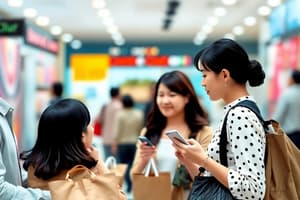Podcast
Questions and Answers
What distinguishes primary groups from secondary groups?
What distinguishes primary groups from secondary groups?
- The presence of leaders within the group
- The frequency of contact members have (correct)
- The size of the group
- The location of group meetings
Which group is characterized by individuals wishing to belong to it?
Which group is characterized by individuals wishing to belong to it?
- Membership groups
- Formal groups
- Aspirational groups (correct)
- Reference groups
What role in the family purchasing process typically initiates the buying decision?
What role in the family purchasing process typically initiates the buying decision?
- Influencer
- User
- Decider
- Initiator (correct)
Which of the following best describes the family of orientation?
Which of the following best describes the family of orientation?
How do personal factors influence consumer behavior?
How do personal factors influence consumer behavior?
What is typically a characteristic of reference groups?
What is typically a characteristic of reference groups?
Which family role is primarily responsible for making the final decision on a purchase?
Which family role is primarily responsible for making the final decision on a purchase?
What aspect of lifestyle influences an individual's consumer behavior?
What aspect of lifestyle influences an individual's consumer behavior?
What primarily defines a consumer market?
What primarily defines a consumer market?
Which statement best describes the concept of personal consumption?
Which statement best describes the concept of personal consumption?
Which of the following factors is NOT a characteristic that affects consumer behavior?
Which of the following factors is NOT a characteristic that affects consumer behavior?
What role does the buyer's black box play in consumer behavior?
What role does the buyer's black box play in consumer behavior?
Social class can be determined by which of the following factors?
Social class can be determined by which of the following factors?
Which factor is considered a cultural characteristic affecting consumer behavior?
Which factor is considered a cultural characteristic affecting consumer behavior?
Reference groups influence consumer behavior primarily through which aspect?
Reference groups influence consumer behavior primarily through which aspect?
Why is market research important in understanding consumer behavior?
Why is market research important in understanding consumer behavior?
What motivates a need to become a motive?
What motivates a need to become a motive?
Which category is NOT part of the SRI VALS lifestyle classifications?
Which category is NOT part of the SRI VALS lifestyle classifications?
Which is an example of a basic orientation according to SINUS GmbH?
Which is an example of a basic orientation according to SINUS GmbH?
What does self-concept primarily refer to?
What does self-concept primarily refer to?
Which of the following is NOT considered a high order need in Maslow's hierarchy?
Which of the following is NOT considered a high order need in Maslow's hierarchy?
In what scenario would high order needs appear according to Maslow’s theory?
In what scenario would high order needs appear according to Maslow’s theory?
Which personality characteristic is NOT commonly recognized as part of an individual's psychological makeup?
Which personality characteristic is NOT commonly recognized as part of an individual's psychological makeup?
What is the focus of consumption in relation to self-concept?
What is the focus of consumption in relation to self-concept?
What is a typical strategy used by brand leaders to promote habitual buying behavior?
What is a typical strategy used by brand leaders to promote habitual buying behavior?
Which of the following best describes the buyer decision process's first stage?
Which of the following best describes the buyer decision process's first stage?
What leads consumers to engage in variety-seeking behavior?
What leads consumers to engage in variety-seeking behavior?
In the information search stage, what might a consumer do if they have a strong drive and a satisfying product at hand?
In the information search stage, what might a consumer do if they have a strong drive and a satisfying product at hand?
Which factors can trigger need recognition in consumers?
Which factors can trigger need recognition in consumers?
What typically characterizes habitual buying behavior?
What typically characterizes habitual buying behavior?
What is a possible outcome when a consumer has a need but no immediate product available?
What is a possible outcome when a consumer has a need but no immediate product available?
Why might price and sales promotions be strong drives for consumers in habitual buying scenarios?
Why might price and sales promotions be strong drives for consumers in habitual buying scenarios?
Which of the following is considered a public source of information for consumers?
Which of the following is considered a public source of information for consumers?
What is a key difference between 'importance' and 'saliency' in consumer decision making?
What is a key difference between 'importance' and 'saliency' in consumer decision making?
In the conjunctive model of consumer choice, what is the primary requirement for a product?
In the conjunctive model of consumer choice, what is the primary requirement for a product?
Which of the following best describes the expectancy value model of consumer choice?
Which of the following best describes the expectancy value model of consumer choice?
What can significantly influence a consumer's purchase decision?
What can significantly influence a consumer's purchase decision?
What is a potential behavior that consumers may exhibit during the purchase decision phase?
What is a potential behavior that consumers may exhibit during the purchase decision phase?
What type of source relies on firsthand experience with the product for information?
What type of source relies on firsthand experience with the product for information?
Why do marketers want to understand how consumers evaluate alternatives?
Why do marketers want to understand how consumers evaluate alternatives?
What does the term 'CUES' refer to in the buying process?
What does the term 'CUES' refer to in the buying process?
Which type of buying behavior is characterized by high involvement and significant differences among brands?
Which type of buying behavior is characterized by high involvement and significant differences among brands?
What is an example of personal risk in the purchasing decision process?
What is an example of personal risk in the purchasing decision process?
What type of risk is associated with spending a lot of money on a purchase?
What type of risk is associated with spending a lot of money on a purchase?
What can attitudes, as described in the content, be based on?
What can attitudes, as described in the content, be based on?
Which of the following statements best describes dissonance-reducing buying behavior?
Which of the following statements best describes dissonance-reducing buying behavior?
Which of the following is NOT a type of perceived risk during the purchasing process?
Which of the following is NOT a type of perceived risk during the purchasing process?
What behavior is likely when a consumer feels a significant risk associated with a purchase?
What behavior is likely when a consumer feels a significant risk associated with a purchase?
Flashcards
Involvement in Buying
Involvement in Buying
The degree to which a consumer is engaged in the purchasing process. It's influenced by factors like perceived risk and the importance of the purchase.
Complex Buying Behavior
Complex Buying Behavior
A type of buying behavior involving a high degree of involvement and significant differences between brands. It typically involves expensive, risky, infrequent purchases with high self-expression.
Dissonance-Reducing Buying Behavior
Dissonance-Reducing Buying Behavior
A type of buying behavior characterized by high involvement but few perceived differences between brands. It's common for expensive, infrequent purchases where the buyer experiences a degree of post-purchase anxiety.
Aspirational Groups
Aspirational Groups
Signup and view all the flashcards
Membership Groups
Membership Groups
Signup and view all the flashcards
Reference Groups
Reference Groups
Signup and view all the flashcards
Family of Orientation
Family of Orientation
Signup and view all the flashcards
Family of Procreation
Family of Procreation
Signup and view all the flashcards
Initiator
Initiator
Signup and view all the flashcards
Influencer
Influencer
Signup and view all the flashcards
Decider
Decider
Signup and view all the flashcards
Perception
Perception
Signup and view all the flashcards
Motivation
Motivation
Signup and view all the flashcards
Maslow's Hierarchy of Needs
Maslow's Hierarchy of Needs
Signup and view all the flashcards
Personality
Personality
Signup and view all the flashcards
Self-concept
Self-concept
Signup and view all the flashcards
Lifestyle Classifications
Lifestyle Classifications
Signup and view all the flashcards
SRI VALS
SRI VALS
Signup and view all the flashcards
SINUS GmbH
SINUS GmbH
Signup and view all the flashcards
Consumer Purchase Behavior
Consumer Purchase Behavior
Signup and view all the flashcards
Buyer's Black Box
Buyer's Black Box
Signup and view all the flashcards
Culture
Culture
Signup and view all the flashcards
Subculture
Subculture
Signup and view all the flashcards
Social Class
Social Class
Signup and view all the flashcards
Cultural Learning
Cultural Learning
Signup and view all the flashcards
Targeting Consumers
Targeting Consumers
Signup and view all the flashcards
Convenience-Driven Purchase
Convenience-Driven Purchase
Signup and view all the flashcards
Habitual Buying Behavior
Habitual Buying Behavior
Signup and view all the flashcards
Variety-Seeking Behavior
Variety-Seeking Behavior
Signup and view all the flashcards
Need Recognition
Need Recognition
Signup and view all the flashcards
Internal Stimuli
Internal Stimuli
Signup and view all the flashcards
External Stimuli
External Stimuli
Signup and view all the flashcards
Information Search
Information Search
Signup and view all the flashcards
Direct Purchase
Direct Purchase
Signup and view all the flashcards
Experiential Sources
Experiential Sources
Signup and view all the flashcards
Commercial Sources
Commercial Sources
Signup and view all the flashcards
Public Sources
Public Sources
Signup and view all the flashcards
Personal Sources
Personal Sources
Signup and view all the flashcards
Evaluation of Alternatives
Evaluation of Alternatives
Signup and view all the flashcards
Attribute Importance
Attribute Importance
Signup and view all the flashcards
Expectancy Value Model
Expectancy Value Model
Signup and view all the flashcards
Purchase Decision
Purchase Decision
Signup and view all the flashcards
Study Notes
Consumer Markets
- A consumer market involves the personal consumption of final goods by individuals or households for their own use, distinct from businesses purchasing goods for resale or production.
- Consumer buying behavior is the process of individuals and households acquiring goods and services for personal use.
Characteristics Affecting Consumer Behavior
- Marketers need to understand how consumers react to marketing stimuli.
- The "buyer's black box" represents the complex decision-making process consumers undergo.
- Marketers use research to understand how consumers react to products, pricing, promotion, and distribution strategies.
- Various factors impact consumer behavior.
Factors Affecting Consumer Behavior
- Cultural:
- Culture encompasses learned values, perceptions, wants, and behaviors from family and other important social institutions.
- Subcultures are groups of people sharing value systems based on common life experiences and situations.
- Social:
- Social class refers to relatively permanent and ordered divisions within a society, where members share similar values, interests, and behaviors.
- Reference groups are groups with a direct influence (membership groups) or aspirational influence (aspirational groups).
- Family is the most influential buying organization affecting consumer behavior, with both orientation and procreation families shaping consumer decisions.
- Personal:
- Age and life-cycle stage: people's needs and wants evolve based on their life stage (youth, middle age, etc).
- Occupation and economic situation impact purchasing decisions.
- Lifestyle, or the pattern of living as expressed in activities, interests, and opinions, profoundly influences choices.
- Personality and self-concept, unique psychological traits, lead to consistent responses in decision-making.
- Psychological:
- Motivation drives consumer behavior from unsatisfied needs like hunger, safety, social needs, esteem, and self-actualization.
- Perception describes how people select, arrange, and interpret information to make sense of their world.
- Learning influences behavior through experiences and interactions, including drives, stimuli, cues, responses, and reinforcements.
- Beliefs and attitudes affect perceptions and evaluations of products and brands.
Types of Buying Decision Behavior
- Involvement and the perceived risk associated with the purchase affect the consumer's decision process.
Studying That Suits You
Use AI to generate personalized quizzes and flashcards to suit your learning preferences.




